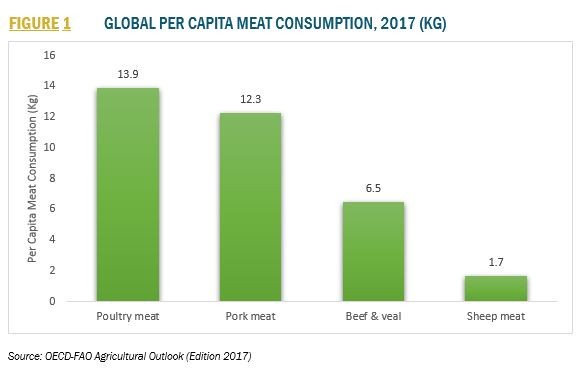Meat testing gained market attention after the 2013 horse meat scandal in Europe. The global trade of meat & seafood has been growing tremendously and is rapidly evolving in complexity. As consumers are becoming aware of various technologies, their expectations of information on testing methods have increased. Outbreaks of diseases due to contaminated meat & seafood have transformed the industry, leading to increased government regulations on meat products and their quality. The meat testing market has been witnessing significant growth since the last decade. This significant growth is attributed to the rising number of adulteration cases, stringent food labeling regulations, religious & ethical concerns, and rising concerns about food safety. These incidences have also led to concerns about the integrity of meat products. Owing to these concerns and the resultant demand for testing, the market for meat & seafood testing is projected to reach USD 11.48 billion by 2023, at a CAGR of 7.7% from 2018.
Increasing demand for meat & seafood
The demand for processed meat and seafood products is increasing significantly. Processed products increase the number of stakeholders in the supply chain, creating a complex supply chain. Due to the complexity of the supply chain, incidents of cross-contamination, adulteration, false labeling, and residues become prominent. Improper termination of contaminants followed by the consumption of these products may induce symptoms that can range from mild to life-threatening. Factors such as these generating the demand for meat & seafood testing. Due to rising concerns pertaining to consumer health issues, there are increased efforts by testing service providers in the industry to monitor the microbiological status of meat & seafood products, and by regulatory authorities to implement new requirements and procedures for meat & seafood testing.
According to the Global Islamic Economy Report published in 2015, the global halal food industry is projected to grow from USD 795.00 billion in 2014 to USD 2.537 trillion by 2019. Thus, with the increasing demand for halal-certified food products, the market for meat & seafood testing is also projected to grow at a significant rate.

Growing cases of meat adulteration to trigger the market growth
A worldwide increase in malpractices and in the number of fraud and adulteration incidents in meat & seafood products has resulted in enhanced growth of the meat & seafood testing market. In the latest publication by the Congressional Research Service in 2014, the share of meat & meat products in food fraud incidents experienced a significant increase from less than 1.0% from 1980 to 2010 to more than 7% from 1980 to 2013; which means an increase of 6.0% in a span of three years (from 2010 to 2013). These statistics are based on the number of incidents recorded. The number of adulteration cases and food frauds is estimated to be even higher. Thus, given the widespread cases of adulteration and fraud, along with the rising consumer concerns for safety and quality, the market for meat & seafood testing is projected to grow at a significant rate in the coming years.
Download PDF Brochure @ https://www.marketsandmarkets.com/pdfdownload.asp?id=60189057
PCR technology is projected to be the fastest-growing segment, in terms of technology, by 2023
The various technologies used in meat & seafood testing are PCR, immunoassay, chromatography, and spectroscopy. PCR is the dominant meat & seafood testing technology. Significant growth in the adoption of this technology for meat & seafood testing can be attributed to DNA analysis conducted for accurate determination of contaminants such as pathogens, adulterant species, GMO, or allergens in meat & seafood products, even at 0.1% levels of detection (LoD). Another advantage of PCR technology is the automated approach to testing, which provides quick results and aids the decision-making process for product recalls, further distribution of products, and other related strategies of stakeholders.
High-growth opportunities from emerging economies
There is a growing demand for meat & seafood testing worldwide, especially in the emerging economies of Asia, Africa, and South America due to the growing international trade. Brazil and Africa present high-growth opportunities for the meat & seafood testing market due to increased meat and seafood export volumes. According to a report published by Farmers Weekly Magazine of South Africa, Brazil exported about 1.85 million tons of red meat in 2016, which was 19.6% of the global red meat export volume, whereas South Africa exported about 60,000 tons of red meat and secured the 15th position in the world. African meat exporters are targeting China and other Asian countries due to the future growth prospects of red meat consumption in the region. Increasing aquaculture production in emerging economies also offers growth opportunities for the seafood testing market.
Other than emerging economies, other opportunities for market growth appear in the form of the following:
- Launch of advanced technologies
- Upgradation of new technologies by service providers
- Increase in R&D activities
- Development in rapid testing technologies for low turnaround time
- Multi-contaminant detection systems
- Expansions in the service portfolio for meat testing in areas of organic meat and cultured meat
However, the growing demand for meat substitutes is creating a challenge for the growth of the meat & seafood testing market. Consumer inclination toward meat substitutes is increasing due to the following reasons:
- Rising health concerns as a result of increasing obesity levels brought on by the excess consumption of meat products
- Health benefits of meat substitutes
Increased shift toward vegetarian and vegan foods
To speak to our analyst for a discussion on the above findings, click Speak to Analyst
